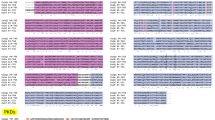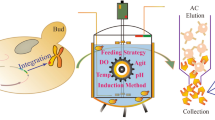Abstract
Prokaryotic proteins with extended collagen domain are found in many bacterial species that are pathogenic to humans and animals. The collagen domain is often fused to additional ligand-binding domains and plays both structural and functional roles in modular “bacterial collagens.” Here, we describe the step-by-step expression and purification of the recombinant streptococcal collagen-like proteins, rScl, using the Strep-tag II system. The integrity and structural characterization of recombinant collagen-like proteins is very important for defining their function.
Access this chapter
Tax calculation will be finalised at checkout
Purchases are for personal use only
Similar content being viewed by others
References
Exposito JY, Valcourt U, Cluzel C et al (2010) The fibrillar collagen family. Int J Mol Sci 11(2):407–426. https://doi.org/10.3390/ijms11020407
Doxey AC, McConkey BJ (2013) Prediction of molecular mimicry candidates in human pathogenic bacteria. Virulence 4(6):453–466. https://doi.org/10.4161/viru.25180
Lukomski S, Bachert BA, Squeglia F et al (2017) Collagen-like proteins of pathogenic streptococci. Mol Microbiol 103(6):919–930. https://doi.org/10.1111/mmi.13604
Lukomski S, Nakashima K, Abdi I et al (2000) Identification and characterization of the scl gene encoding a group a Streptococcus extracellular protein virulence factor with similarity to human collagen. Infect Immun 68(12):6542–6553. https://doi.org/10.1128/iai.68.12.6542-6553.2000
Lukomski S, Nakashima K, Abdi I et al (2001) Identification and characterization of a second extracellular collagen-like protein made by group A Streptococcus: control of production at the level of translation. Infect Immun 69(3):1729–1738. https://doi.org/10.1128/iai.69.3.1729-1738.2001
Rasmussen M, Björck L (2001) Unique regulation of SclB - a novel collagen-like surface protein of Streptococcus pyogenes. Mol Microbiol 40(6):1427–1438
Rasmussen M, Edén A, Björck L (2000) SclA, a novel collagen-like surface protein of Streptococcus pyogenes. Infect Immun 68(11):6370–6377. https://doi.org/10.1128/iai.68.11.6370-6377.2000
Whatmore AM (2001) Streptococcus pyogenes sclB encodes a putative hypervariable surface protein with a collagen-like repetitive structure. Microbiology 147(Pt 2):419–429. https://doi.org/10.1099/00221287-147-2-419
Xu Y, Keene DR, Bujnicki JM et al (2002) Streptococcal Scl1 and Scl2 proteins form collagen-like triple helices. J Biol Chem 277(30):27312–27318. https://doi.org/10.1074/jbc.M201163200
Xu C, Yu Z, Inouye M et al (2010) Expanding the family of collagen proteins: recombinant bacterial collagens of varying composition form triple-helices of similar stability. Biomacromolecules 11(2):348–356. https://doi.org/10.1021/bm900894b
Caswell CC, Barczyk M, Keene DR et al (2008) Identification of the first prokaryotic collagen sequence motif that mediates binding to human collagen receptors, integrins α2β1 and α11β1. J Biol Chem 283(52):36168–36175
Humtsoe JO, Kim JK, Xu Y et al (2005) A streptococcal collagen-like protein interacts with the α2β1 integrin and induces intracellular signaling. J Biol Chem 280(14):13848–13857
Caswell CC, Oliver-Kozup H, Han R et al (2010) Scl1, the multifunctional adhesin of group a Streptococcus, selectively binds cellular fibronectin and laminin, and mediates pathogen internalization by human cells. FEMS Microbiol Lett 303(1):61–68. https://doi.org/10.1111/j.1574-6968.2009.01864.x
Caswell CC, Han R, Hovis KM et al (2008) The Scl1 protein of M6-type group A Streptococcus binds the human complement regulatory protein, factor H, and inhibits the alternative pathway of complement. Mol Microbiol 67(3):584–596. https://doi.org/10.1111/j.1365-2958.2007.06067.x
Han R, Caswell CC, Lukomska E et al (2006) Binding of the low-density lipoprotein by streptococcal collagen-like protein Scl1 of Streptococcus pyogenes. Mol Microbiol 61(2):351–367. https://doi.org/10.1111/j.1365-2958.2006.05237.x
Påhlman LI, Marx PF, Mӧrgelin M et al (2007) Thrombin-activatable fibrinolysis inhibitor binds to Streptococcus pyogenes by interacting with collagen-like proteins A and B. J Biol Chem 282(34):24873–24881. https://doi.org/10.1074/jbc.M610015200
Reuter M, Caswell CC, Lukomski S et al (2010) Binding of the human complement regulators CFHR1 and factor H by streptococcal collagen-like protein 1 (Scl1) via their conserved C termini allows control of the complement cascade at multiple levels. J Biol Chem 285(49):38473–38485. https://doi.org/10.1074/jbc.M110.143727
Squeglia F, Bachert B, De Simone A et al (2014) The crystal structure of the streptococcal collagen-like protein 2 globular domain from invasive M3-type group A Streptococcus shows significant similarity to immunomodulatory HIV protein gp41. J Biol Chem 289(8):5122–5133. https://doi.org/10.1074/jbc.M113.523597
McNitt DH, Choi SJ, Allen JL et al (2019) Adaptation of the group A Streptococcus adhesin Scl1 to bind fibronectin type III repeats within wound-associated extracellular matrix: implications for cancer therapy. Mol Microbiol 112(3):800–819. https://doi.org/10.1111/mmi.14317
McNitt DH, Choi SJ, Keene DR et al (2018) Surface-exposed loops and an acidic patch in the Scl1 protein of group A Streptococcus enable Scl1 binding to wound-associated fibronectin. J Biol Chem 293(20):7796–7810. https://doi.org/10.1074/jbc.RA118.002250
Golser AV, Scheibel T (2018) Routes towards novel collagen-like biomaterials. Fibers 6(2):21. https://doi.org/10.3390/fib6020021
Han R, Zwiefka A, Caswell CC et al (2006) Assessment of prokaryotic collagen-like sequences derived from streptococcal Scl1 and Scl2 proteins as a source of recombinant GXY polymers. Appl Microbiol Biotechnol 72(1):109–115. https://doi.org/10.1007/s00253-006-0387-5
Peng YY, Howell L, Stoichevska V et al (2012) Towards scalable production of a collagen-like protein from Streptococcus pyogenes for biomedical applications. Microb Cell Factories 11:146–146. https://doi.org/10.1186/1475-2859-11-146
Peng YY, Stoichevska V, Madsen S et al (2014) A simple cost-effective methodology for large-scale purification of recombinant non-animal collagens. Appl Microbiol Biotechnol 98(4):1807–1815. https://doi.org/10.1007/s00253-013-5475-8
Cosgriff-Hernandez E, Hahn MS, Russell B et al (2010) Bioactive hydrogels based on designer collagens. Acta Biomater 6(10):3969–3977. https://doi.org/10.1016/j.actbio.2010.05.002
Yoshizumi A, Fletcher JM, Yu Z et al (2011) Designed coiled coils promote folding of a recombinant bacterial collagen. J Biol Chem 286(20):17512–17520. https://doi.org/10.1074/jbc.M110.217364
Peng YY, Stoichevska V, Schacht K et al (2014) Engineering multiple biological functional motifs into a blank collagen-like protein template from Streptococcus pyogenes. J Biomed Mater Res A 102(7):2189–2196. https://doi.org/10.1002/jbm.a.34898
Yu Z, An B, Ramshaw JA et al (2014) Bacterial collagen-like proteins that form triple-helical structures. J Struct Biol 186(3):451–461. https://doi.org/10.1016/j.jsb.2014.01.003
Yu Z, Visse R, Inouye M et al (2012) Defining requirements for collagenase cleavage in collagen type III using a bacterial collagen system. J Biol Chem 287(27):22988–22997. https://doi.org/10.1074/jbc.M112.348979
Seo N, Russell BH, Rivera JJ et al (2010) An engineered alpha1 integrin-binding collagenous sequence. J Biol Chem 285(40):31046–31054. https://doi.org/10.1074/jbc.M110.151357
Bronk JK, Russell BH, Rivera JJ et al (2014) A multifunctional streptococcal collagen-mimetic protein coating prevents bacterial adhesion and promotes osteoid formation on titanium. Acta Biomater 10(7):3354–3362. https://doi.org/10.1016/j.actbio.2014.04.005
An B, DesRochers TM, Qin G et al (2013) The influence of specific binding of collagen-silk chimeras to silk biomaterials on hMSC behavior. Biomaterials 34(2):402–412. https://doi.org/10.1016/j.biomaterials.2012.09.085
Parmar PA, St-Pierre JP, Chow LW et al (2016) Harnessing the versatility of bacterial collagen to improve the chondrogenic potential of porous collagen scaffolds. Adv Healthc Mater 5(13):1656–1666. https://doi.org/10.1002/adhm.201600136
Peng YY, Yoshizumi A, Danon SJ et al (2010) A Streptococcus pyogenes derived collagen-like protein as a non-cytotoxic and non-immunogenic cross-linkable biomaterial. Biomaterials 31(10):2755–2761. https://doi.org/10.1016/j.biomaterials.2009.12.040
Browning MB, Dempsey D, Guiza V et al (2012) Multilayer vascular grafts based on collagen-mimetic proteins. Acta Biomater 8(3):1010–1021. https://doi.org/10.1016/j.actbio.2011.11.015
Cereceres S, Touchet T, Browning MB et al (2015) Chronic wound dressings based on collagen-mimetic proteins. Adv Wound Care (New Rochelle) 4(8):444–456. https://doi.org/10.1089/wound.2014.0614
Maier T, Drapal N, Thanbichler M et al (1998) Strep-tag II affinity purification: An approach to study intermediates of Metalloenzyme biosynthesis. Anal Biochem 259(1):68–73. https://doi.org/10.1006/abio.1998.2649
Greenfield NJ (2007) Using circular dichroism spectra to estimate protein secondary structure. Nat Protoc 1:2876. https://doi.org/10.1038/nprot.2006.202
Brodsky-Doyle B, Leonard KR, Reid KB (1976) Circular-dichroism and electron-microscopy studies of human subcomponent C1q before and after limited proteolysis by pepsin. Biochem J 159(2):279–286. https://doi.org/10.1042/bj1590279
Sherratt MJ, Graham HK, Kielty CM et al (2000) ECM macromolecules: rotary shadowing and scanning transmission electron microscopy. In: Streuli CH, Grant ME (eds) Extracellular Matrix Protocols. Humana Press, Totowa, NJ, pp 119–132. https://doi.org/10.1385/1-59259-063-2:119
Acknowledgments
We are grateful to all previous and current members of Lukomski’s laboratory for their contributions to the development of the methods and protocols presented here. We also thank our numerous collaborators, especially Doug Keene for performing rotary shadowing and EM imaging over the years. This work was supported by NIH grants AI50666 and AI083683, as well as West Virginia University HSC Bridge Grant Funding to S.L.
Author information
Authors and Affiliations
Corresponding author
Editor information
Editors and Affiliations
Rights and permissions
Copyright information
© 2020 Springer Science+Business Media, LLC, part of Springer Nature
About this protocol
Cite this protocol
Lukomski, S., McNitt, D.H. (2020). Expression and Purification of Collagen-Like Proteins of Group A Streptococcus. In: Proft, T., Loh, J. (eds) Group A Streptococcus. Methods in Molecular Biology, vol 2136. Humana, New York, NY. https://doi.org/10.1007/978-1-0716-0467-0_12
Download citation
DOI: https://doi.org/10.1007/978-1-0716-0467-0_12
Published:
Publisher Name: Humana, New York, NY
Print ISBN: 978-1-0716-0466-3
Online ISBN: 978-1-0716-0467-0
eBook Packages: Springer Protocols




